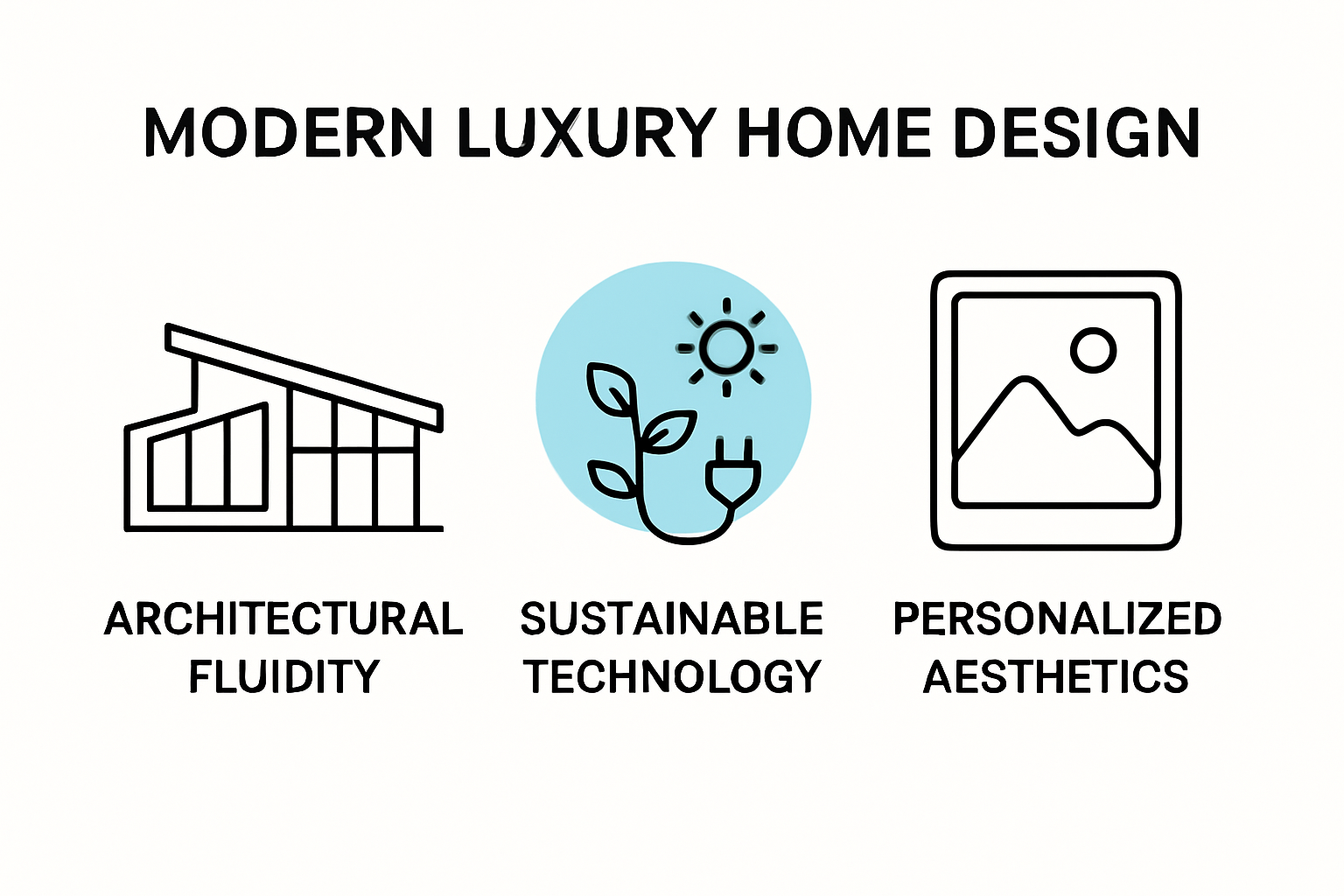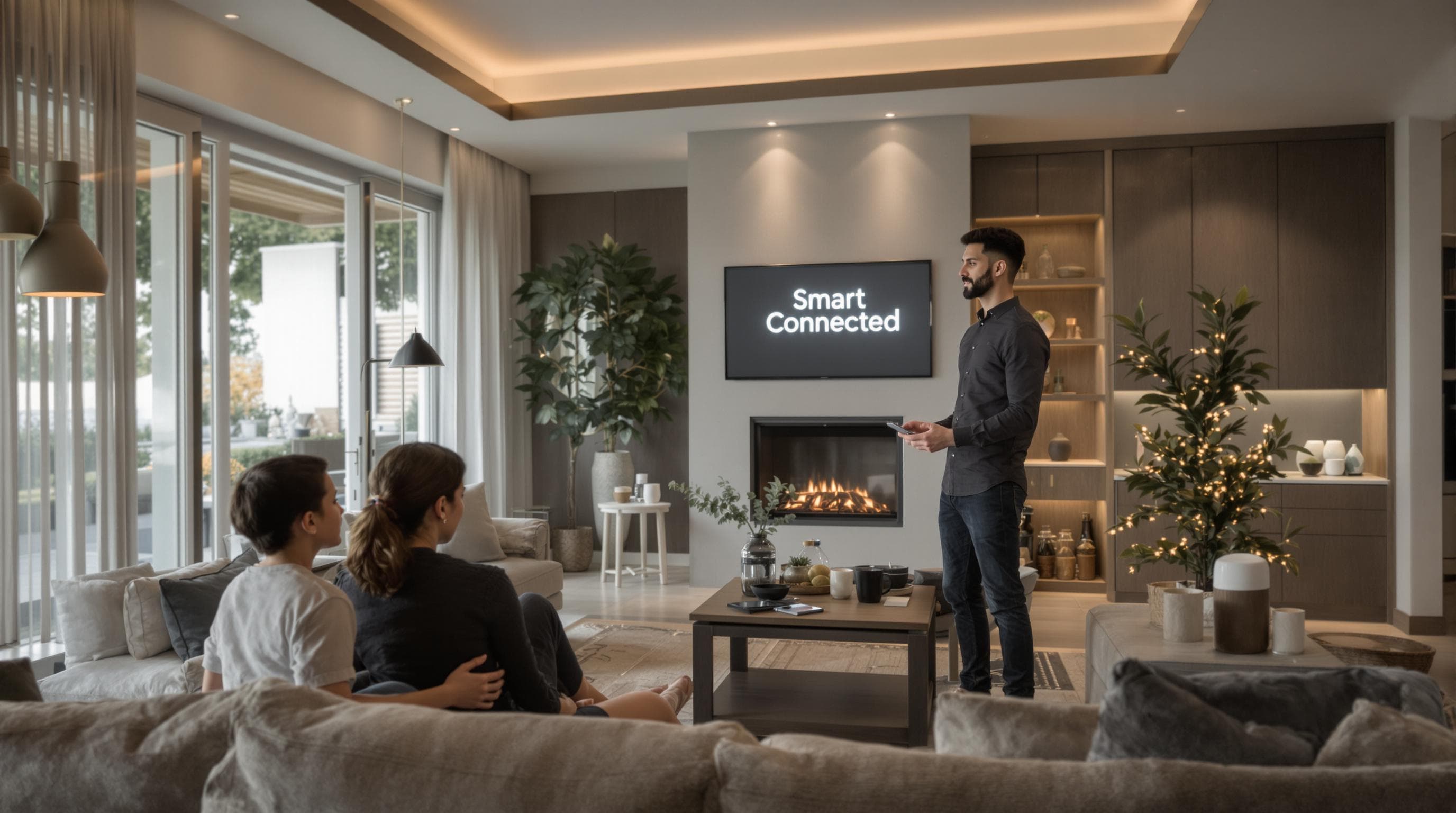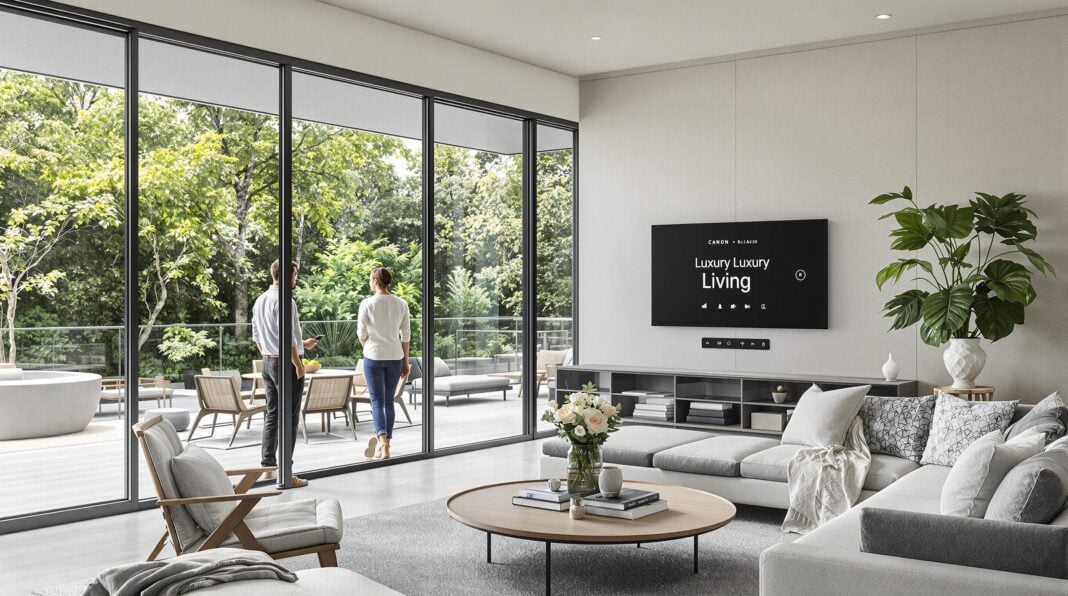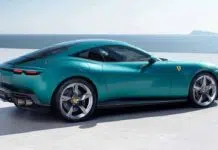Modern luxury homes are redefining what it means to live well, blending sleek design with seamless technology and eco-conscious choices. But luxury in 2025 is not just about style or square footage. Imagine this—over 75 percent of new luxury homes now feature integrated wellness environments and AI-powered smart systems. The real surprise is how personal these spaces have become, as every detail can be tailored to reflect your own tastes and values in ways that were unthinkable just a few years ago.
Table of Contents
- Key Elements Of Modern Luxury Home Design
- Cutting-Edge Technologies Elevating Luxury Living
- Custom Finishes And Materials For Distinctive Homes
- Exclusive Amenities For A Sophisticated Lifestyle
Quick Summary
| Takeaway | Explanation |
|---|---|
| Architectural fluidity enhances living spaces. | Modern luxury homes emphasize seamless transitions between indoor and outdoor environments, creating dynamic living areas that adapt to lifestyle needs. |
| Sustainability is a design requirement. | Luxury home design now integrates eco-friendly technologies like solar panels and energy-efficient systems, reflecting homeowners’ commitment to environmental responsibility. |
| Personalized aesthetics define modern luxury. | Homeowners are selecting unique materials and finishes that reflect their personal style, ensuring that each space is thoughtfully tailored to individual preferences. |
| Advanced technology elevates home environments. | Homes now feature smart systems for comprehensive automation, allowing control over climate, security, and entertainment through user-friendly applications. |
| Wellness spaces promote holistic health. | Luxury homes are incorporating specialized areas for fitness and well-being, supporting both physical and mental health through innovative technologies and thoughtful design. |
Key Elements of Modern Luxury Home Design

Modern luxury home design transcends traditional aesthetics, representing a sophisticated fusion of cutting-edge technology, sustainable practices, and personalized architectural expression. The contemporary luxury home is no longer just a living space but a comprehensive lifestyle statement that reflects the homeowner’s values, technological sophistication, and commitment to exceptional design.
Architectural Fluidity and Spatial Intelligence
Contemporary luxury home design prioritizes architectural fluidity, creating seamless transitions between indoor and outdoor spaces. Architectural Digest highlights that sophisticated homeowners now demand living environments that break conventional spatial boundaries. This approach involves expansive floor-to-ceiling windows, open-concept layouts, and strategic architectural elements that blur the lines between interior and exterior environments.
The concept of spatial intelligence has become paramount in modern luxury home design. Architects are developing intelligent floor plans that maximize natural light, optimize spatial flow, and create multi-functional areas that adapt to changing lifestyle needs. Smart room configurations allow spaces to transform dynamically – a home office can seamlessly transition into an entertainment area, demonstrating the versatility of contemporary design.
Sustainable Technology and Intelligent Systems
Sustainability has evolved from being a trend to a fundamental requirement in modern luxury home design. World Green Building Council reports that high-net-worth individuals are increasingly prioritizing eco-friendly technologies and energy-efficient solutions. This shift involves integrating advanced sustainable technologies such as solar energy systems, geothermal heating, rainwater harvesting, and smart home automation that minimizes environmental impact while maximizing comfort.
Intelligent home systems represent another critical element of modern luxury design. These comprehensive networks integrate cutting-edge technologies like AI-powered climate control, advanced security systems, and automated environmental management. Homeowners can now control lighting, temperature, security, and entertainment systems through sophisticated smartphone applications, creating an unprecedented level of personalized living experience.
Personalized Aesthetic and Material Innovation
Luxury home design in 2025 emphasizes profound personalization and material innovation. Designers are moving beyond standard architectural approaches, creating bespoke environments that reflect individual personalities and lifestyle preferences. This involves utilizing rare, high-quality materials like sustainable hardwoods, recycled metals, and innovative composites that offer both aesthetic beauty and environmental responsibility.
The material palette for modern luxury homes now includes advanced technological innovations. Self-cleaning surfaces, adaptive materials that respond to environmental changes, and integrated smart surfaces are transforming how we perceive residential architecture. These materials not only provide functional benefits but also create visually stunning, technologically advanced living environments that represent the pinnacle of contemporary design.
Modern luxury home design represents a holistic approach that combines technological innovation, sustainable practices, and deeply personalized aesthetic expressions. It is no longer about creating impressive structures but about crafting intelligent, responsive living environments that adapt to and enhance the sophisticated lifestyles of their inhabitants.
Cutting-Edge Technologies Elevating Luxury Living
The intersection of advanced technology and luxury living represents a transformative paradigm where intelligent systems, immersive experiences, and personalized automation redefine residential environments. Modern luxury homes are no longer passive structures but dynamic, responsive ecosystems that anticipate and adapt to their inhabitants’ needs with unprecedented precision.
Immersive Home Automation and AI Integration

Gartner Research predicts that artificial intelligence will become the cornerstone of luxury residential experiences, creating homes that learn, predict, and respond to residents’ preferences in real-time. Advanced AI systems now enable comprehensive environmental management that goes beyond simple temperature or lighting control.
These intelligent systems utilize machine learning algorithms to understand individual lifestyle patterns, automatically adjusting everything from ambient lighting to room temperature, music preferences, and even preparing morning routines before residents fully awaken. Sophisticated sensor networks create a continuous feedback loop, ensuring that each technological interaction feels intuitive and seamlessly personalized.
Biometric Security and Privacy Technologies
Luxury home security has evolved dramatically with the integration of advanced biometric technologies. Forbes Technology Council highlights emerging systems that go far beyond traditional alarm mechanisms. Cutting-edge security now incorporates facial recognition, voice authentication, and advanced behavioral pattern analysis to create multi-layered protection strategies.
These sophisticated security technologies do more than prevent unauthorized access. They create intelligent perimeter management systems that can distinguish between expected and unexpected environmental interactions. Advanced cameras with AI-powered analysis can differentiate between routine movements and potential security threats, sending nuanced alerts that provide context rather than simple alarm triggers.
Wellness and Health-Integrated Smart Environments
The next frontier of luxury living technology focuses on comprehensive wellness integration. Smart home systems now incorporate advanced health monitoring technologies that transform residential spaces into proactive wellness environments. Environmental sensors can track air quality, humidity levels, natural light exposure, and even detect potential health anomalies before they become critical.
Sophisticated wellness technologies can now monitor residents’ physiological parameters, adjusting environmental conditions to optimize sleep quality, reduce stress, and support overall well-being. Integrated systems might automatically adjust lighting to support circadian rhythms, filter indoor air to remove potential allergens, or create acoustic environments that promote relaxation and mental clarity.
Cutting-edge technologies in luxury living represent more than mere technological showcases. They embody a holistic approach to residential design that sees homes as intelligent, responsive ecosystems designed to enhance human experience. By seamlessly integrating advanced technologies, luxury homes are transforming from static structures into dynamic, adaptive environments that anticipate, support, and elevate their inhabitants’ lifestyles.
Custom Finishes and Materials for Distinctive Homes
Custom finishes and materials represent the pinnacle of modern luxury home design, transforming residential spaces from mere living environments into extraordinary expressions of individual aesthetics and technological innovation. These sophisticated design elements go beyond traditional architectural materials, offering homeowners unprecedented opportunities to create truly unique and personalized living experiences.
Sustainable Luxury Materials and Innovative Sourcing
Architectural Digest reports a significant shift towards materials that combine environmental responsibility with exceptional aesthetic quality. Contemporary luxury home design now prioritizes rare, sustainably sourced materials that tell a unique story while minimizing ecological impact. Designers are sourcing materials from innovative global locations, selecting resources that represent both technological advancement and environmental consciousness.
These materials include regenerative hardwoods harvested from managed forests, recycled metals with advanced treatments, and composite materials engineered to provide superior durability and aesthetic appeal. Innovative sourcing strategies ensure that each material not only looks exceptional but also represents a commitment to sustainable design principles. Homeowners can now select finishes that reflect their environmental values without compromising on visual sophistication.
Advanced Surface Technologies and Adaptive Materials
Materials Science Journal highlights emerging surface technologies that transform how we perceive residential materials. Modern luxury homes now incorporate adaptive materials that can change properties in response to environmental conditions. Self-cleaning surfaces, materials with integrated thermal regulation, and surfaces that can alter their visual appearance represent the cutting edge of material innovation.
These advanced materials offer functional benefits beyond traditional aesthetic considerations. Nano-engineered surfaces can repel water, resist staining, and maintain their pristine appearance with minimal maintenance. Some innovative materials can even adjust their thermal properties, helping to regulate indoor temperatures more efficiently than traditional building materials. This represents a profound shift from passive architectural elements to active, responsive design components.
Artisanal Craftsmanship and Global Design Influences
Luxury home design increasingly celebrates global artisanal traditions while incorporating contemporary technological innovations. Designers are collaborating with master craftspeople from around the world to create bespoke finishes that blend traditional techniques with modern design sensibilities. This approach allows homeowners to incorporate unique, handcrafted elements that tell a rich cultural narrative.
Traditional techniques like Japanese wood joining methods, Italian marble sculpting, and Brazilian indigenous weaving are being reimagined through a contemporary lens. These artisanal approaches are combined with advanced manufacturing technologies, creating finishes that are simultaneously rooted in cultural heritage and forward-looking in their execution. Each material and finish becomes a deliberate design choice that reflects the homeowner’s global perspective and aesthetic sophistication.
Custom finishes and materials in modern luxury homes represent far more than mere decorative choices. They are complex, multilayered design statements that communicate individual values, technological appreciation, and a profound understanding of global design aesthetics. By carefully selecting and integrating these advanced materials, homeowners can create living spaces that are truly extraordinary – environments that transcend traditional architectural boundaries and represent the pinnacle of contemporary design innovation.
To help readers quickly compare the different types of custom finishes and sourcing methods, the following table summarizes the three major material strategies discussed above:
| Strategy | Description | Example Materials/Techniques |
|---|---|---|
| Sustainable Luxury Materials | Prioritizing rare, eco-friendly, and responsibly sourced materials | Regenerative hardwoods, recycled metals, composites |
| Advanced Surface Technologies & Adaptivity | Using materials and finishes that change based on environmental conditions or offer innovative new functions | Self-cleaning surfaces, thermal-regulating materials |
| Artisanal Craftsmanship & Global Influences | Incorporating traditional, handcrafted elements from global design cultures, often updated with modern methods | Japanese wood joints, Italian marble, indigenous weaving |
Exclusive Amenities for a Sophisticated Lifestyle
Luxury living in 2025 transcends traditional residential expectations, offering comprehensive lifestyle experiences that seamlessly integrate personal wellness, entertainment, and professional productivity within the home environment. Modern sophisticated homeowners demand amenities that reflect their multifaceted lifestyles and provide unparalleled convenience and exceptional experiences.
Wellness and Holistic Health Environments
Global Wellness Institute reports a significant transformation in residential wellness amenities, with luxury homes now incorporating dedicated spaces that support comprehensive physical and mental well-being. These are not mere exercise rooms but sophisticated wellness ecosystems designed to optimize personal health through integrated technologies and purposeful design.
These wellness environments feature advanced fitness technologies like virtual training systems, personalized health monitoring equipment, and spa-grade treatment areas. Meditation rooms with acoustic engineering, chromotherapy lighting, and air purification systems create holistic spaces that support mental restoration. Some luxury homes now include cryotherapy chambers, infrared saunas, and professional-grade rehabilitation zones that previously existed only in high-end medical facilities.
Professional and Creative Workspaces
Harvard Business Review highlights the evolution of home professional environments, recognizing that luxury residences must now accommodate sophisticated work requirements. Modern luxury homes integrate professional workspaces that are far more than traditional home offices, offering technologically advanced environments that support complex professional and creative endeavors.
These dedicated workspaces feature soundproofed rooms with professional-grade acoustic design, high-speed connectivity infrastructure, and modular furniture systems that can transform based on specific work requirements. Advanced video conferencing stations with studio-quality lighting and acoustics enable seamless professional interactions. Some luxury homes now include specialized spaces for content creation, featuring professional recording studios, photography zones, and collaborative meeting areas that rival corporate innovation centers.
Entertainment and Social Interaction Zones
Luxury home entertainment has evolved beyond traditional media rooms, creating immersive social experiences that blend cutting-edge technology with sophisticated design. These spaces are engineered to provide unparalleled audiovisual experiences while maintaining aesthetic elegance. Advanced projection systems, adaptive sound environments, and interactive multimedia platforms transform entertainment from a passive to an engaging experience.
Entertainment zones now include features like professional-grade wine cellars with climate-controlled storage, mixology stations with custom bar designs, and outdoor entertainment areas with integrated cooking facilities. Some luxury homes incorporate virtual reality entertainment rooms that can simulate global travel experiences, provide interactive gaming environments, or host immersive cultural experiences.
Exclusive amenities in modern luxury homes represent more than mere architectural additions. They are carefully curated lifestyle ecosystems that anticipate and exceed the sophisticated expectations of discerning homeowners. By integrating advanced technologies, personalized design, and comprehensive wellness concepts, these amenities transform residential spaces into dynamic environments that support, inspire, and elevate individual lifestyles.
To help readers understand the differences between major amenity categories in modern luxury homes, the following table summarizes each along with its defining features:
| Amenity Category | Key Features/Details |
|---|---|
| Wellness & Holistic Health | Dedicated spa areas, meditation rooms, fitness tech, wellness monitoring, cryotherapy/sauna, air purification |
| Professional & Creative Workspaces | Soundproofing, studio lighting, video conferencing tech, modular furniture, content creation zones, high-speed net |
| Entertainment & Social Zones | Advanced AV, adaptive acoustics, wine cellars, mixology bars, VR rooms, outdoor kitchens, immersive experience tech |
Frequently Asked Questions
What are the key elements of modern luxury home design trends for 2025?
Modern luxury home design trends for 2025 emphasize architectural fluidity, sustainability, personalized aesthetics, and advanced technology integration, allowing for adaptable and personalized living environments.
How are wellness and health incorporated into luxury home designs?
Luxury homes in 2025 increasingly feature integrated wellness environments that promote physical and mental well-being, including dedicated fitness spaces, meditation rooms, and advanced health monitoring technologies.
What types of technologies are transforming luxury homes?
Cutting-edge technologies in luxury homes include AI-powered home automation systems, biometric security measures, and smart environments that adjust to residents’ preferences for enhanced comfort and convenience.
How do modern luxury homes prioritize sustainable materials?
Modern luxury home design prioritizes sustainable materials by incorporating eco-friendly options, such as responsibly sourced hardwoods, recycled metals, and advanced surface technologies that minimize environmental impact while ensuring aesthetic appeal.
Elevate Your Luxury Home Experience with Upscale Living Mag
Feeling overwhelmed by the fast pace of modern luxury home design? This article explained how new trends combine technology, eco-friendly materials, and wellness spaces for the ultimate personalized lifestyle. As affluent homeowners strive for seamless living environments and exclusive amenities, finding reliable insights and inspiration becomes essential for turning vision into reality. Upscale Living Mag bridges this gap by curating the very best ideas and solutions for high-end living, just as discussed in our feature on wellness architecture, custom finishes, and intelligent home systems.





